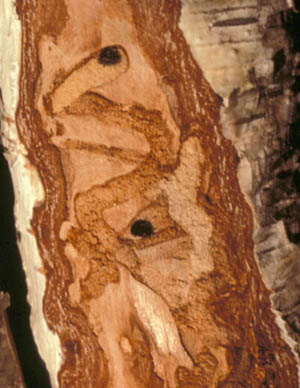Bronze Birch Borer | |
|---|---|
| May 8, 2006 | |
As Vanhoutte spirea, Spiraea x vanhouttei, nears the completion of blooming, European white birch, gray birch, paper birch, and yellow birch trees in landscapes are susceptible to the bronze birch borer, Agrilus anxius. Adult bronze birch borers are coppery brown to black in color, with a boat-shaped abdomen. Adult females are strong fliers and tend to lay eggs near the tops of trees in cracks, crevices, or under loose bark. Egg-laying sites are typically located on the sunny side of host trees. After about 2 weeks, eggs hatch into larvae that tunnel directly into the bark (cambium) and begin creating feeding galleries. These galleries may be 3 to 5 inches in length and packed with excrement. The larvae are nearly 1.5 inches long, ivory-colored, and flat, with a head that is wider than the body. Larval feeding can result in girdling of the trunk or branches. Infested trees typically have ridged or swollen bark where the larvae have created a zigzag pattern under the bark during feeding. Bronze birch borer overwinters as a late-instar larva underneath the tree trunk. The larvae pupate near the bark surface. Adult emerge in late May through early June, by chewing a D-shaped hole in the bark (this is the same size of hole as the emerald ash borer creates). Adults feed on the leaves of alder, birch, and poplar. There is only one generation per year in Illinois. Bronze birch borer emergence holes Bronze birch borer emergence holes Bronze birch borer tunneling damage Bronze birch borer tunneling damageThe primary way of managing bronze birch borer is by prevention. Bronze birch borer prefers to attack “stressed” trees because the borers are unable to survive in healthy trees. As a result, proper watering, fertility, mulching, and pruning are practices that go a long way in reducing problems with bronze birch borer. Birches should not be pruned between May 1 and August 1 because this is the general flight period of the bronze birch borer adults, and females are attracted to the volatiles emitted from pruning cuts. In addition, selecting less susceptible varieties of birch (Betula spp.), such as ‘Heritage’ and ‘Whitespire’ may result in fewer problems with bronze birch borer. The insecticide recommended for managing bronze birch borer is imidacloprid (for example, Merit). Imidicloprid may be applied as a drench (= soil incorporation) to the soil, where it is taken up by the roots and distributed throughout the tree. The active ingredient contacts larvae in the cambium and/or kills adults that feed on foliage. Imidacloprid may also be applied by direct injection into the tree. This is referred to as “microinjection.” There are a number products containing imidacloprid and application systems (techniques for applying them) available. Contact an arborist or tree-care professional on the timing of injecting imidacloprid into trees. It is important to understand that the movement of imidacloprid, regardless of the application technique, is reduced if trees are stressed. |